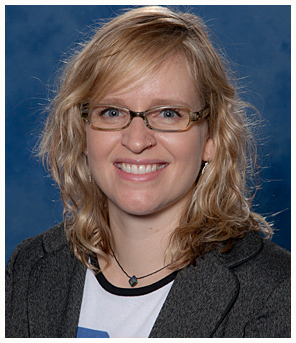Ingrid Daubar
NASA Postdoctoral Fellow, JPL
 What’s your current position (and where) and what does your research/work focus on?
What’s your current position (and where) and what does your research/work focus on?
I’m a NASA Postdoctoral Fellow working at the Jet Propulsion Laboratory. Currently I’m working on the InSight mission that will study the interior of Mars.
We’re using HiRISE images to find the safest place for it to land. The seismometer on the lander will be able to detect not just Marsquakes, but also impacts of meteoroids on the
Martian surface. I am using the research I did with HiRISE on new craters to predict the impacts that InSight will be able to sense. After landing, we of course hope to get
HiRISE images of the new craters that InSight detects with its seismometer.
Previously, I worked at the HiRISE Operations Center (HiROC) doing uplink operations for nine years. I was part of the team that targets places on Mars to image, adjusts the camera
settings, and writes the commands that are uplinked to the spacecraft. Over that time, I planned 6,620 images of Mars! I also worked with HiRISE data doing research on new,
dated impact craters that formed within the last few years; frost avalanches off scarps at the north pole; evidence of past water and lava flows in Mangala Valles; and
using craters to estimate the age of the North Polar cap.
What got you interested in planetary science?
I was fortunate that my high school had a planetarium. The class I took there piqued my interest, so I decided to study astronomy in college. I asked my professor if I could
work with him, and he hired me to do research on the rings of Jupiter. I realized that I found it a lot more exciting to study planets we can actually visit and hold pieces of
in our hands, rather than stars that are unreachable in our lifetimes. So I chose to focus on planetary sciences. That led to grad school at the University of Arizona, and
eventually an operations job at HiRISE. When I was working at HiROC, the fantastic science and operations teams there encouraged me to continue in my research.
Why is your subject of study/research important to you?
I still have fun doing my job on most days, which seems to be rare for most people. It’s different every day, and there are always new challenges. I enjoy solving problems,
which is what both science and operations are really all about. When I think about the big picture as well, it’s pretty amazing what we get to do: explore other planets!
It’s inspiring to be a part of that endeavor.
What would you suggest to a young person to study if he/she is interested in planetary science?
There are lots of ways to get involved in planetary science. If you want to get into the science/research side, study physics and math, and depending on your focus, geology,
chemistry, or astronomy as well. However, HiRISE employs not just scientists, but also engineers, computer programmers, communicators, and educators. There are even opportunities
for students to get involved. The most important things are to find an aspect that you’re excited about, and be willing to work hard in whatever area you specialize in.
About HiRISE
The HiRISE camera onboard the Mars Reconnaissance Orbiter is the most powerful one of its kind ever sent to another planet. Its high resolution allows
us to see Mars like never before, and helps other missions choose a safe spot to land for future exploration.
NASA’s Jet Propulsion Laboratory, a division of the California Institute of Technology in Pasadena, Calif., manages the Mars Reconnaissance
Orbiter for NASA’s Science Mission Directorate, Washington. Lockheed Martin Space Systems is the prime contractor for the project and
built the spacecraft. The HiRISE camera was built by Ball Aerospace & Technologies Corp. and is operated by the
University of Arizona.
 What’s your current position (and where) and what does your research/work focus on?
What’s your current position (and where) and what does your research/work focus on?